点击上方“CSDN”,选择“置顶公众号”
关键时刻,第一时间送达!
【CSDN 编者按】一个月前,我们曾发表过一篇标题为《三年后,人工智能将彻底改变前端开发?》的文章,其中介绍了一个彼时名列 GitHub 排行榜 TOP 1 的项目 —— Screenshot-to-code-in-Keras。在这个项目中,神经网络通过深度学习,自动把设计稿变成 HTML 和 CSS 代码,同时其作者 Emil Wallner 表示,“三年后,人工智能将彻底改变前端开发”。
这个 Flag 一立,即引起了国内外非常热烈的讨论,有喜有忧,有褒扬有反对。对此,Emil Wallner 则以非常严谨的实践撰写了系列文章,尤其是在《Turning Design Mockups Into Code With Deep Learning》一文中,详细分享了自己是如何根据 pix2code 等论文构建了一个强大的前端代码生成模型,并细讲了其利用 LSTM 与 CNN 将设计原型编写为 HTML 和 CSS 网站的过程。
以下为全文:
在未来三年内,深度学习将改变前端开发,它可以快速创建原型,并降低软件开发的门槛。
去年,该领域取得了突破性的进展,其中 Tony Beltramelli 发表了 pix2code 的论文[1],而 Airbnb 则推出了sketch2code[2]。
目前,前端开发自动化的最大障碍是计算能力。但是,现在我们可以使用深度学习的算法,以及合成的训练数据,探索人工前端开发的自动化。
本文中,我们将展示如何训练神经网络,根据设计图编写基本的 HTML 和 CSS 代码。以下是该过程的简要概述:
-
提供设计图给经过训练的神经网络
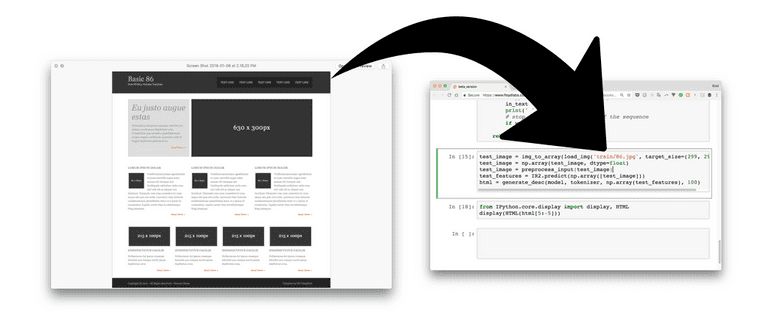
-
神经网络把设计图转化成 HTML 代码
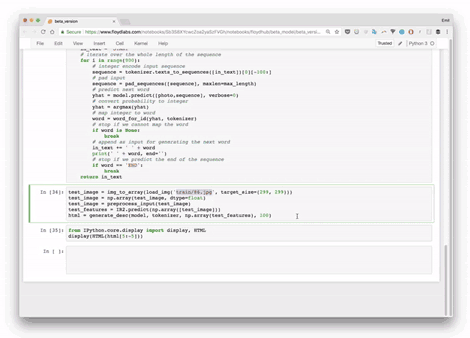
大图请点:https://blog.floydhub.com/generate_html_markup-b6ceec69a7c9cfd447d188648049f2a4.gif
-
渲染画面
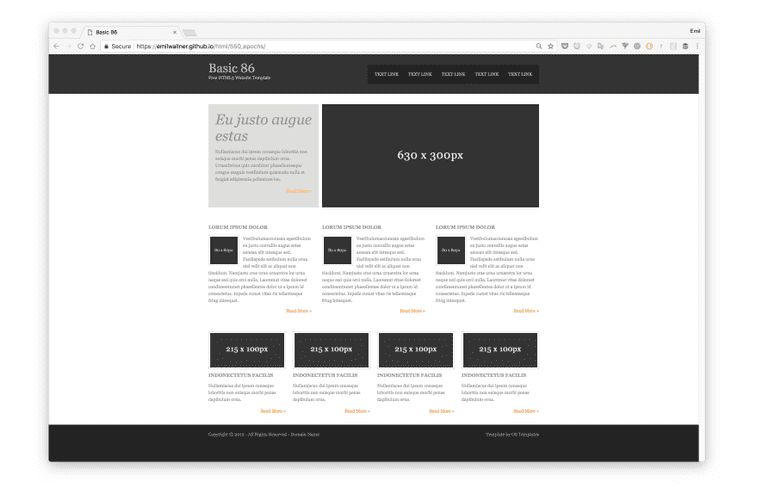
我们将通过三次迭代建立这个神经网络。
首先,我们建立一个简化版,掌握基础结构。第二个版本是 HTML,我们将集中讨论每个步骤的自动化,并解释神经网络的各层。在最后一个版本——Boostrap 中,我们将创建一个通用的模型来探索 LSTM 层。
你可以通过 Github[3] 和 FloydHub[4] 的 Jupyter notebook 访问我们的代码。所有的 FloydHub notebook 都放在“floydhub”目录下,而 local 的东西都在“local”目录下。
这些模型是根据 Beltramelli 的 pix2code 论文和 Jason Brownlee 的“图像标注教程”[5]创建的。代码的编写采用了 Python 和 Keras(TensorFlow 的上层框架)。
如果你刚刚接触深度学习,那么我建议你先熟悉下 Python、反向传播算法、以及卷积神经网络。你可以阅读我之前发表的三篇文章:
-
开始学习深度学习的第一周[6]
-
通过编程探索深度学习发展史[7]
-
利用神经网络给黑白照片上色[8]
核心逻辑
我们的目标可以概括为:建立可以生成与设计图相符的 HTML 及 CSS 代码的神经网络。
在训练神经网络的时候,你可以给出几个截图以及相应的 HTML。
神经网络通过逐个预测与之匹配的 HTML 标签进行学习。在预测下一个标签时,神经网络会查看截图以及到这个点为止的所有正确的 HTML 标签。
下面的 Google Sheet 给出了一个简单的训练数据:
https://docs.google.com/spreadsheets/d/1xXwarcQZAHluorveZsACtXRdmNFbwGtN3WMNhcTdEyQ/edit?usp=sharing
当然,还有其他方法[9]可以训练神经网络,但创建逐个单词预测的模型是目前最普遍的做法,所以在本教程中我们也使用这个方法。
请注意每次的预测都必须基于同一张截图,所以如果神经网络需要预测 20 个单词,那么它需要查看同一张截图 20 次。暂时先把神经网络的工作原理放到一边,让我们先了解一下神经网络的输入和输出。
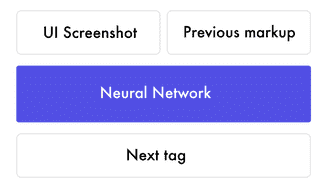
让我们先来看看“之前的 HTML 标签”。假设我们需要训练神经网络预测这样一个句子:“I can code。”当它接收到“I”的时候,它会预测“can”。下一步它接收到“I can”,继续预测“code”。也就是说,每一次神经网络都会接收所有之前的单词,但是仅需预测下一个单词。

神经网络根据数据创建特征,它必须通过创建的特征把输入数据和输出数据连接起来,它需要建立一种表现方式来理解截图中的内容以及预测到的 HTML 语法。这个过程积累的知识可以用来预测下个标签。
利用训练好的模型开展实际应用与训练模型的过程很相似。模型会按照同一张截图逐个生成文本。所不同的是,你无需提供正确的 HTML 标签,模型只接受迄今为止生成过的标签,然后预测下一个标签。预测从“start”标签开始,当预测到“end”标签或超过最大限制时终止。下面的 Google Sheet 给出了另一个例子:
https://docs.google.com/spreadsheets/d/1yneocsAb_w3-ZUdhwJ1odfsxR2kr-4e_c5FabQbNJrs/edit#gid=0
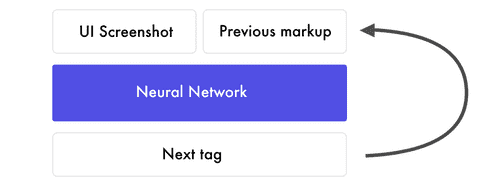
Hello World 版本
让我们试着创建一个“hello world”的版本。我们给神经网络提供一个显示“Hello World”的网页截图,并教它怎样生成 HTML 代码。
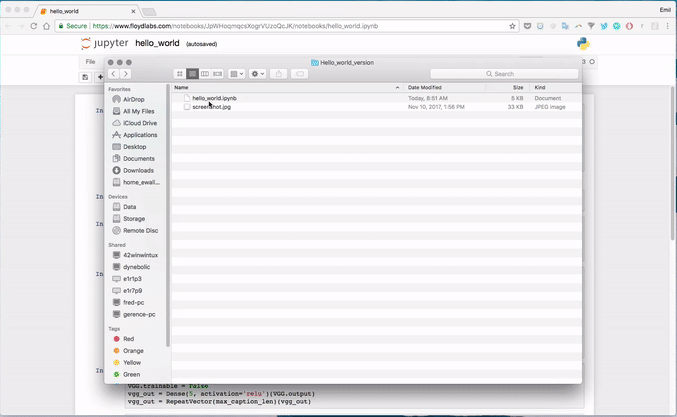
大图请点:https://blog.floydhub.com/hello_world_generation-039d78c27eb584fa639b89d564b94772.gif
首先,神经网络将设计图转化成一系列的像素值,每个像素包含三个通道(红蓝绿),数值为 0-255。
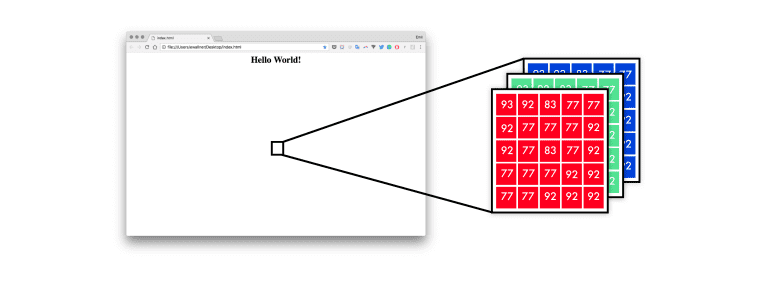
我在这里使用 one-hot 编码[10]来描述神经网络理解 HTML 代码的方式。句子“I can code”的编码如下图所示:
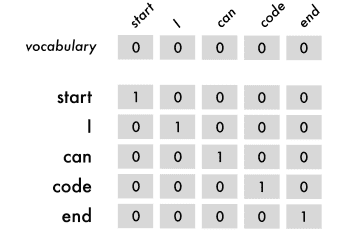
上图的例子中加入了“start”和“end”标签。这些标签可以提示神经网络从哪里开始预测,到哪里停止预测。
我们用句子作为输入数据,第一个句子只包含第一个单词,以后每次加入一个新单词。而输出数据始终只有一个单词。
句子的逻辑与单词相同,但它们还需要保证输入数据具有相同的长度。单词的上限是词汇表的大小,而句子的上限则是句子的最大长度。如果句子的长度小于最大长度,就用空单词补齐——空单词就是全零的单词。
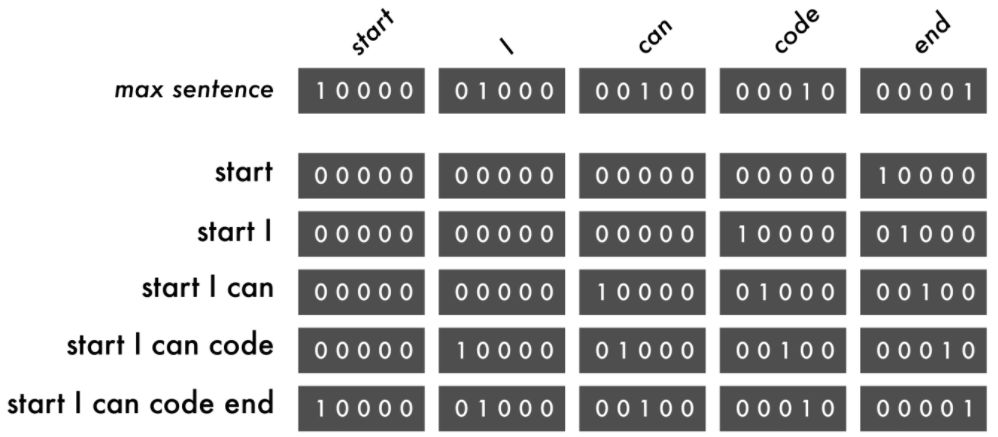
如上图所示,单词是从右向左排列的,这样可以强迫每个单词在每轮训练中改变位置。这样模型就能学习单词的顺序,而非记住每个单词的位置。
下图是四次预测,每行代表一次预测。等式左侧是用红绿蓝三个通道的数值表示的图像,以及之前的单词。括号外面是每次的预测,最后一个红方块代表结束。

#Length of longest sentence
max_caption_len = 3
#Size of vocabulary
vocab_size = 3
# Load one screenshot for each word and turn them into digits
images = []
for i in range(2):
images.append(img_to_array(load_img('screenshot.jpg', target_size=(224, 224))))
images = np.array(images, dtype=float)
# Preprocess input for the VGG16 model
images = preprocess_input(images)
#Turn start tokens into one-hot encoding
html_input = np.array(
[[[0., 0., 0.], #start
[0., 0., 0.],
[1., 0., 0.]],
[[0., 0., 0.], #start <HTML>Hello World!</HTML>
[1., 0., 0.],
[0., 1., 0.]]])
#Turn next word into one-hot encoding
next_words = np.array(
[[0., 1., 0.], # <HTML>Hello World!</HTML>
[0., 0., 1.]]) # end
# Load the VGG16 model trained on imagenet and output the classification feature
VGG = VGG16(weights='imagenet', include_top=True)
# Extract the features from the image
features = VGG.predict(images)
#Load the feature to the network, apply a dense layer, and repeat the vector
vgg_feature = Input(shape=(1000,))
vgg_feature_dense = Dense(5)(vgg_feature)
vgg_feature_repeat = RepeatVector(max_caption_len)(vgg_feature_dense)
# Extract information from the input seqence
language_input = Input(shape=(vocab_size, vocab_size))
language_model = LSTM(5, return_sequences=True)(language_input)
# Concatenate the information from the image and the input
decoder = concatenate([vgg_feature_repeat, language_model])
# Extract information from the concatenated output
decoder = LSTM(5, return_sequences=False)(decoder)
# Predict which word comes next
decoder_output = Dense(vocab_size, activation='softmax')(decoder)
# Compile and run the neural network
model = Model(inputs=[vgg_feature, language_input], outputs=decoder_output)
model.compile(loss='categorical_crossentropy', optimizer='rmsprop')
# Train the neural network
model.fit([features, html_input], next_words, batch_size=2, shuffle=False, epochs=1000)
在 hello world 版本中,我们用到了 3 个 token,分别是“start”、“<HTML><center><H1>Hello World!</H1></center></HTML>”和“end”。token 可以代表任何东西,可以是一个字符、单词或者句子。选择字符作为 token 的好处是所需的词汇表较小,但是会限制神经网络的学习。选择单词作为 token 具有最好的性能。
接下来进行预测:
# Create an empty sentence and insert the start token
sentence = np.zeros((1, 3, 3)) # [[0,0,0], [0,0,0], [0,0,0]]
start_token = [1., 0., 0.] # start
sentence[0][2] = start_token # place start in empty sentence
# Making the first prediction with the start token
second_word = model.predict([np.array([features[1]]), sentence])
# Put the second word in the sentence and make the final prediction
sentence[0][1] = start_token
sentence[0][2] = np.round(second_word)
third_word = model.predict([np.array([features[1]]), sentence])
# Place the start token and our two predictions in the sentence
sentence[0][0] = start_token
sentence[0][1] = np.round(second_word)
sentence[0][2] = np.round(third_word)
# Transform our one-hot predictions into the final tokens
vocabulary = ["start", "<HTML><center><H1>Hello World!</H1></center></HTML>", "end"]
for i in sentence[0]:
print(vocabulary[np.argmax(i)], end=' ')
输出结果
-
10 epochs:start start start
-
100 epochs:start <HTML><center><H1>Hello World!</H1></center></HTML> <HTML><center><H1>Hello World!</H1></center></HTML>
-
300 epochs:start <HTML><center><H1>Hello World!</H1></center></HTML> end
在这之中,我犯过的错误
-
先做出可以运行的第一版,再收集数据。在这个项目的早期,我曾成功地下载了整个 Geocities 托管网站的一份旧的存档,里面包含了 3800 万个网站。由于神经网络强大的潜力,我没有考虑到归纳一个 10 万大小词汇表的巨大工作量。
-
处理 TB 级的数据需要好的硬件或巨大的耐心。在我的 Mac 遇到几个难题后,我不得不使用强大的远程服务器。为了保证工作流程的顺畅,需要做好心里准备租用一台 8 CPU 和 1G 带宽的矿机。
-
关键在于搞清楚输入和输出数据。输入 X 是一张截图和之前的 HTML 标签。而输出 Y 是下一个标签。当我明白了输入和输出数据之后,理解其余内容就很简单了。试验不同的架构也变得更加容易。
-
保持专注,不要被诱惑。因为这个项目涉及了深度学习的许多领域,很多地方让我深陷其中不能自拔。我曾花了一周的时间从头开始编写 RNN,也曾经沉迷于嵌入向量空间,还陷入过极限实现方式的陷阱。
-
图片转换到代码的网络只不过是伪装的图像标注模型。即使我明白这一点,但还是因为许多图像标注方面的论文不够炫酷而忽略了它们。掌握一些这方面的知识可以帮助我们加速学习问题空间。
在 FloydHub 上运行代码
FloydHub 是深度学习的训练平台。我在刚开始学习深度学习的时候发现了这个平台,从那以后我一直用它训练和管理我的深度学习实验。你可以在 10 分钟之内安装并开始运行模型,它是在云端 GPU 上运行模型的最佳选择。
如果你没用过 FloydHub,请参照官方的“2 分钟安装手册”或我写的“5 分钟入门教程”[11]。
克隆代码仓库:
git clone https://github.com/emilwallner/Screenshot-to-code-in-Keras.git
登录及初始化 FloydHub 的命令行工具:
cd Screenshot-to-code-in-Keras
floyd login
floyd init s2c在 FloydHub 的云端 GPU 机器上运行 Jupyter notebook:
floyd run --gpu --env tensorflow-1.4 --data emilwallner/datasets/imagetocode/2:data --mode jupyter
所有的 notebook 都保存在“FloydHub”目录下,而 local 的东西都在“local”目录下。运行之后,你可以在如下文件中找到第一个 notebook:
floydhub/Helloworld/helloworld.ipynb
如果你想了解详细的命令参数,请参照我这篇帖子:
https://blog.floydhub.com/colorizing-b&w-photos-with-neural-networks/
HTML 版本
在这个版本中,我们将自动化 Hello World 模型中的部分步骤。本节我们将集中介绍如何让模型处理任意多的输入数据,以及建立神经网络中的关键部分。
这个版本还不能根据任意网站预测 HTML,但是我们将在此尝试解决关键性的技术问题,向最终的成功迈进一大步。
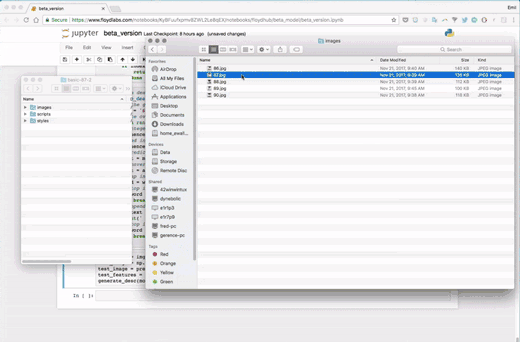
概述
我们可以把之前的解说图扩展为如下:
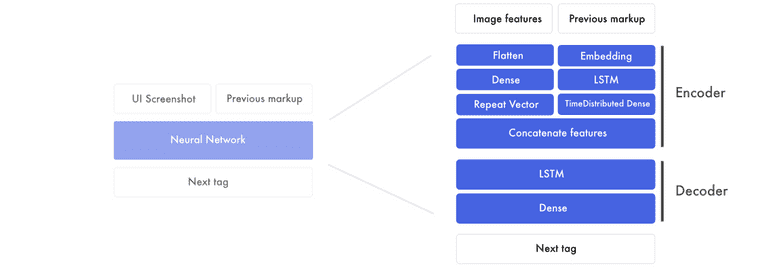
上图中有两个主要部分。首先是编码部分。编码部分负责建立图像特征和之前的标签特征。特征是指神经网络创建的最小单位的数据,用于连接设计图和 HTML 代码。在编码部分的最后,我们把图像的特征连接到之前的标签的每个单词。
另一个主要部分是解码部分。解码部分负责接收聚合后的设计图和 HTML 代码的特征,并创建下一个标签的特征。这个特征通过一个全连接神经网络来预测下一个标签。
设计图的特征
由于我们需要给每个单词添加一张截图,所以这会成为训练神经网络过程中的瓶颈。所以我们不直接使用图片,而是从中提取生成标签所必需的信息。
提取的信息经过编码后保存在图像特征中。这项工作可以由事先训练好的卷积神经网络(CNN)完成。该模型可以通过 ImageNet 上的数据进行训练。
CNN 的最后一层是分类层,我们可以从前一层提取图像特征。

最终我们可以得到 1536 个 8x8 像素的图片作为特征。尽管我们很难理解这些特征的含义,但是神经网络可以从中提取元素的对象和位置。
HTML 标签的特征
在 hello world 版本中,我们采用了 one-hot 编码表现 HTML 标签。在这个版本中,我们将使用单词嵌入(word embedding)作为输入信息,输出依然用 one-hot 编码。
我们继续采用之前的方式分析句子,但是匹配每个 token 的方式有所变化。之前的 one-hot 编码把每个单词当成一个独立的单元,而这里我们把输入数据中的每个单词转化成一系列数字,它们代表 HTML 标签之间的关系。

上例中的单词嵌入是 8 维的,而实际上根据词汇表的大小,其维度会在 50 到 500 之间。
每个单词的 8 个数字表示权重,与原始的神经网络很相似。它们表示单词之间的关系(Mikolov 等,2013[12])。
以上就是我们建立 HTML 标签特征的过程。神经网络通过此特征在输入和输出数据之间建立联系。暂时先不用担心具体的内容,我们会在下节中深入讨论这个问题。
编码部分
我们需要把单词嵌入的结果输入到 LSTM 中,并返回一系列标签特征,再把这些特征送入 Time distributed dense 层——你可以认为这是拥有多个输入和输出的 dense 层。
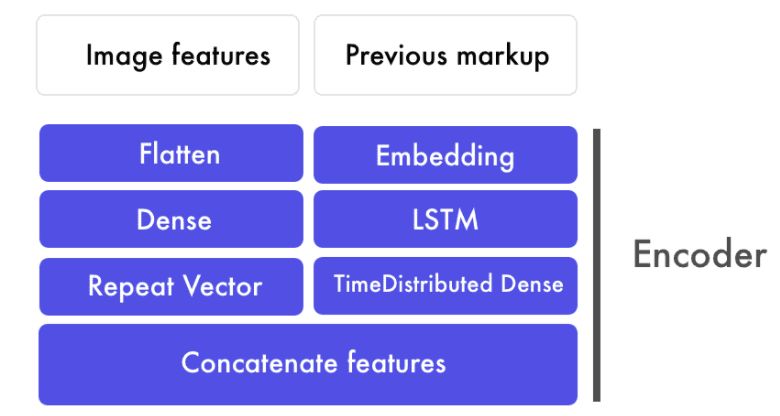
同时,图像特征首先需要被展开(flatten),无论数值原来是什么结构,它们都会被转换成一个巨大的数值列表;然后经过 dense 层建立更高级的特征;最后把这些特征与 HTML 标签的特征连接起来。
这可能有点难理解,下面我们逐一分解开来看看。
HTML 标签特征
首先我们把单词嵌入的结果输入到 LSTM 层。如下图所示,所有的句子都被填充到最大长度,即三个 token。

为了混合这些信号并找到更高层的模式,我们加入 TimeDistributed dense 层进一步处理 LSTM 层生成的 HTML 标签特征。TimeDistributed dense 层是拥有多个输入和输出的 dense 层。
图像特征
同时,我们需要处理图像。我们把所有的特征(小图片)转化成一个长数组,其中包含的信息保持不变,只是进行重组。

同样,为了混合信号并提取更高层的信息,我们添加一个 dense 层。由于输入只有一个,所以我们可以使用普通的 dense 层。为了与 HTML 标签特征相连接,我们需要复制图像特征。
上述的例子中我们有三个 HTML 标签特征,因此最终图像特征的数量也同样是三个。
连接图像特征和 HTML 标签特征
所有的句子经过填充后组成了三个特征。因为我们已经准备好了图像特征,所以现在可以把图像特征分别添加到各自的 HTML 标签特征。

添加完成之后,我们得到了 3 个图像-标签特征,这便是我们需要提供给解码部分的输入信息。
解码部分
接下来,我们使用图像-标签的结合特征来预测下一个标签。
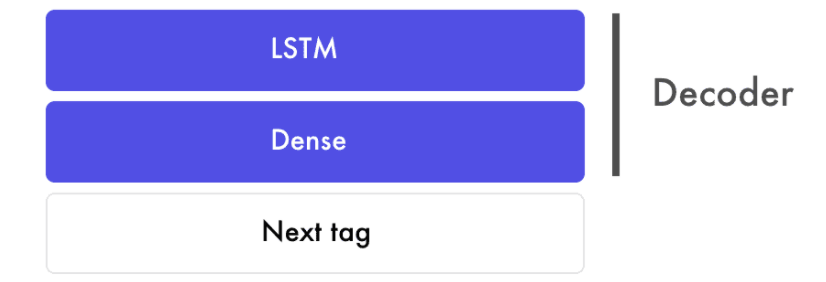
在下面的例子中,我们使用三对图形-标签特征,输出下一个标签的特征。
请注意,LSTM 层的 sequence 值为 false,所以我们不需要返回输入序列的长度,只需要预测一个特征,也就是下一个标签的特征,其内包含了最终的预测信息。

最终预测
dense 层的工作原理与传统的前馈神经网络相似,它把下个标签特征的 512 个数字与 4 个最终预测连接起来。用我们的单词表达就是:start、hello、world 和 end。
其中,dense 层的 softmax 激活函数会生成 0-1 的概率分布,所有预测值的总和等于 1。比如说词汇表的预测可能是[0.1,0.1,0.1,0.7],那么输出的预测结果即为:第 4 个单词是下一个标签。然后,你可以把 one-hot 编码[0,0,0,1]转换为映射值,得出“end”。
# Load the images and preprocess them for inception-resnet
images = []
all_filenames = listdir('images/')
all_filenames.sort()
for filename in all_filenames:
images.append(img_to_array(load_img('images/'+filename, target_size=(299, 299))))
images = np.array(images, dtype=float)
images = preprocess_input(images)
# Run the images through inception-resnet and extract the features without the classification layer
IR2 = InceptionResNetV2(weights='imagenet', include_top=False)
features = IR2.predict(images)
# We will cap each input sequence to 100 tokens
max_caption_len = 100
# Initialize the function that will create our vocabulary
tokenizer = Tokenizer(filters='', split=" ", lower=False)
# Read a document and return a string
def load_doc(filename):
file = open(filename, 'r')
text = file.read()
file.close()
return text
# Load all the HTML files
X = []
all_filenames = listdir('html/')
all_filenames.sort()
for filename in all_filenames:
X.append(load_doc('html/'+filename))
# Create the vocabulary from the html files
tokenizer.fit_on_texts(X)
# Add +1 to leave space for empty words
vocab_size = len(tokenizer.word_index) + 1
# Translate each word in text file to the matching vocabulary index
sequences = tokenizer.texts_to_sequences(X)
# The longest HTML file
max_length = max(len(s) for s in sequences)
# Intialize our final input to the model
X, y, image_data = list(), list(), list()
for img_no, seq in enumerate(sequences):
for i in range(1, len(seq)):
# Add the entire sequence to the input and only keep the next word for the output
in_seq, out_seq = seq[:i], seq[i]
# If the sentence is shorter than max_length, fill it up with empty words
in_seq = pad_sequences([in_seq], maxlen=max_length)[0]
# Map the output to one-hot encoding
out_seq = to_categorical([out_seq], num_classes=vocab_size)[0]
# Add and image corresponding to the HTML file
image_data.append(features[img_no])
# Cut the input sentence to 100 tokens, and add it to the input data
X.append(in_seq[-100:])
y.append(out_seq)
X, y, image_data = np.array(X), np.array(y), np.array(image_data)
# Create the encoder
image_features = Input(shape=(8, 8, 1536,))
image_flat = Flatten()(image_features)
image_flat = Dense(128, activation='relu')(image_flat)
ir2_out = RepeatVector(max_caption_len)(image_flat)
language_input = Input(shape=(max_caption_len,))
language_model = Embedding(vocab_size, 200, input_length=max_caption_len)(language_input)
language_model = LSTM(256, return_sequences=True)(language_model)
language_model = LSTM(256, return_sequences=True)(language_model)
language_model = TimeDistributed(Dense(128, activation='relu'))(language_model)
# Create the decoder
decoder = concatenate([ir2_out, language_model])
decoder = LSTM(512, return_sequences=False)(decoder)
decoder_output = Dense(vocab_size, activation='softmax')(decoder)
# Compile the model
model = Model(inputs=[image_features, language_input], outputs=decoder_output)
model.compile(loss='categorical_crossentropy', optimizer='rmsprop')
# Train the neural network
model.fit([image_data, X], y, batch_size=64, shuffle=False, epochs=2)
# map an integer to a word
def word_for_id(integer, tokenizer):
for word, index in tokenizer.word_index.items():
if index == integer:
return word
return None
# generate a description for an image
def generate_desc(model, tokenizer, photo, max_length):
# seed the generation process
in_text = 'START'
# iterate over the whole length of the sequence
for i in range(900):
# integer encode input sequence
sequence = tokenizer.texts_to_sequences([in_text])[0][-100:]
# pad input
sequence = pad_sequences([sequence], maxlen=max_length)
# predict next word
yhat = model.predict([photo,sequence], verbose=0)
# convert probability to integer
yhat = np.argmax(yhat)
# map integer to word
word = word_for_id(yhat, tokenizer)
# stop if we cannot map the word
if word is None:
break
# append as input for generating the next word
in_text += ' ' + word
# Print the prediction
print(' ' + word, end='')
# stop if we predict the end of the sequence
if word == 'END':
break
return
# Load and image, preprocess it for IR2, extract features and generate the HTML
test_image = img_to_array(load_img('images/87.jpg', target_size=(299, 299)))
test_image = np.array(test_image, dtype=float)
test_image = preprocess_input(test_image)
test_features = IR2.predict(np.array([test_image]))
generate_desc(model, tokenizer, np.array(test_features), 100)
输出结果

生成网站的链接:
-
250 epochs: https://emilwallner.github.io/html/250_epochs/
-
350 epochs:https://emilwallner.github.io/html/350_epochs/
-
450 epochs:https://emilwallner.github.io/html/450_epochs/
-
550 epochs:https://emilwallner.github.io/html/450_epochs/
如果点击上述链接看不到页面的话,你可以选择“查看源代码”。下面是原网站的链接,仅供参考:
https://emilwallner.github.io/html/Original/
我犯过的错误
-
与 CNN 相比,LSTM 远比我想像得复杂。为了更好的理解,我展开了所有的 LSTM。关于 RNN 你可以参考这个视频(http://course.fast.ai/lessons/lesson6.html)。另外,在理解原理之前,请先搞清楚输入和输出特征。
-
从零开始创建词汇表比削减大型词汇表更容易。词汇表可以包括任何东西,如字体、div 大小、十六进制颜色、变量名以及普通单词。
-
大多数的代码库可以很好地解析文本文档,却不能解析代码。因为文档中所有单词都用空格分开,但是代码不同,所以你得自己想办法解析代码。
-
用 Imagenet 训练好的模型提取特征也许不是个好主意。因为 Imagenet 很少有网页的图片,所以它的损失率比从零开始训练的 pix2code 模型高 30%。如果使用网页截图训练 inception-resnet 之类的模型,不知结果会怎样。
Bootstrap 版本
在最后一个版本——Bootstrap 版本中,我们使用的数据集来自根据 pix2code 论文生成的 bootstrap 网站。通过使用 Twitter 的 bootstrap(https://getbootstrap.com/),我们可以结合 HTML 和 CSS,并减小词汇表的大小。
我们可以提供一个它从未见过的截图,训练它生成相应的 HTML 代码。我们还可以深入研究它学习这个截图和 HTML 代码的过程。
抛开 bootstrap 的 HTML 代码,我们在这里使用 17 个简化的 token 训练它,然后翻译成 HTML 和 CSS。这个数据集[13]包括 1500 个测试截图和 250 个验证截图。每个截图上平均有 65 个 token,包含 96925 个训练样本。
通过修改 pix2code 论文的模型提供输入数据,我们的模型可以预测网页的组成,且准确率高达 97%(我们采用了 BLEU 4-ngram greedy search,稍后会详细介绍)。
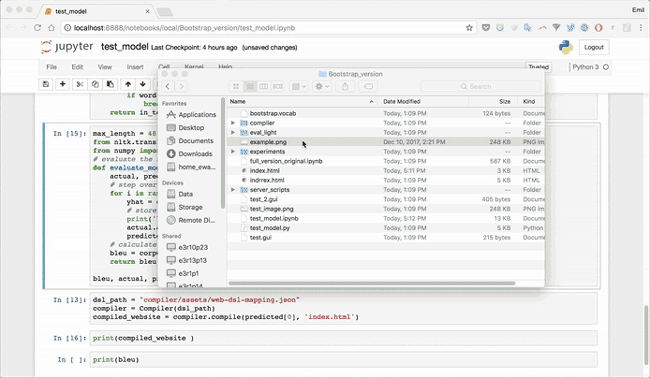
端到端的方法
图像标注模型可以从事先训练好的模型中提取特征,但是经过几次实验后,我发现 pix2code 的端到端的方法可以更好地为我们的模型提取特征,因为事先训练好的模型并没有用网页数据训练过,而且它本来的作用是分类。
在这个模型中,我们用轻量级的卷积神经网络替代了事先训练好的图像特征。我们没有采用 max-pooling 增加信息密度,但我们增加了步长(stride),以确保前端元素的位置和颜色。
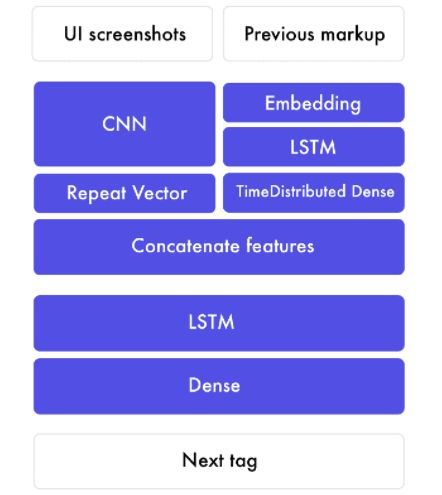
有两个核心模型可以支持这个方法:卷积神经网络(CNN)和递归神经网络(RNN)。最常见的递归神经网络就是 LSTM,所以我选择了 RNN。
关于 CNN 的教程有很多,我在别的文章里有介绍。此处我主要讲解 LSTM。
理解 LSTM 中的 timestep
LSTM 中最难理解的内容之一就是 timestep。原始的神经网络可以看作只有两个 timestep。如果输入是“Hello”(第一个 timestep),它会预测“World”(第二个 timestep),但它无法预测更多的 timestep。下面的例子中输入有四个 timestep,每个词一个。
LSTM 适用于包含 timestep 的输入,这种神经网络专门处理有序的信息。模型展开后你会发现,下行的每一步所持有的权重保持不变。另外,前一个输出和新的输入需要分别使用相应的权重。
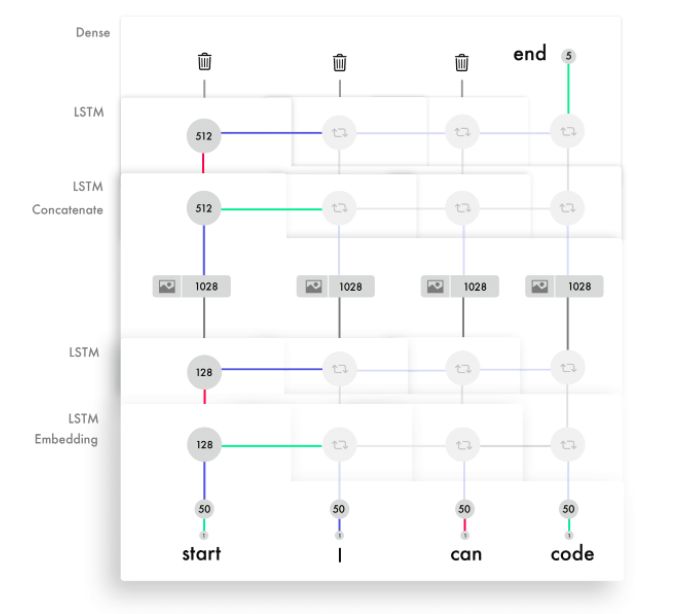
接下来,输入和输出乘以权重之后相加,再通过激活函数得到该 timestep 的输出。由于权重不随 timestep 变化,所以它们可以从多个输入中获得信息,从而掌握单词的顺序。
下图通过简单图例描述了一个 LSTM 中每个 timestep 的处理过程。
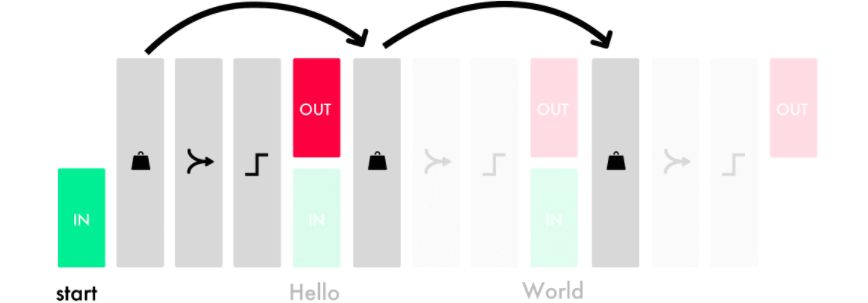
为了更好地理解这个逻辑,我建议你跟随 Andrew Trask 的这篇精彩的教程[14],尝试从头创建一个 RNN。
理解 LSTM 层中的单元
LSTM 层中的单元(unit)数量决定了它的记忆能力,以及每个输出特征的大小。再次强调,特征是一长列的数值,用于在层与层之间的信息传递。
LSTM 层中的每个单元负责跟踪语法中的不同信息。下图描述了一个单元的示例,其内保存了布局行“div”的信息。我们简化了 HTML 代码,并用于训练 bootstrap 模型。

每个 LSTM 单元拥有一个单元状态(cell state)。你可以把单元状态看作单元的记忆。权重和激活函数可以用各种方式改变状态。因此 LSTM 层可以微调每个输入所需要保存和丢弃的信息。
向输入传递输出特征的同时,还需传递单元状态,LSTM 的每个单元都需要传递自己的单元状态值。为了理解 LSTM 各部分的交互方式,我建议你可以阅读:
Colah 的教程:https://colah.github.io/posts/2015-08-Understanding-LSTMs/
Jayasiri 的 Numpy 实现:http://blog.varunajayasiri.com/numpy_lstm.html
Karphay 的讲座和文章:https://www.youtube.com/watch?v=yCC09vCHzF8; https://karpathy.github.io/2015/05/21/rnn-effectiveness/
dir_name = 'resources/eval_light/'
# Read a file and return a string
def load_doc(filename):
file = open(filename, 'r')
text = file.read()
file.close()
return text
def load_data(data_dir):
text = []
images = []
# Load all the files and order them
all_filenames = listdir(data_dir)
all_filenames.sort()
for filename in (all_filenames):
if filename[-3:] == "npz":
# Load the images already prepared in arrays
image = np.load(data_dir+filename)
images.append(image['features'])
else:
# Load the boostrap tokens and rap them in a start and end tag
syntax = '<START> ' + load_doc(data_dir+filename) + ' <END>'
# Seperate all the words with a single space
syntax = ' '.join(syntax.split())
# Add a space after each comma
syntax = syntax.replace(',', ' ,')
text.append(syntax)
images = np.array(images, dtype=float)
return images, text
train_features, texts = load_data(dir_name)
# Initialize the function to create the vocabulary
tokenizer = Tokenizer(filters='', split=" ", lower=False)
# Create the vocabulary
tokenizer.fit_on_texts([load_doc('bootstrap.vocab')])
# Add one spot for the empty word in the vocabulary
vocab_size = len(tokenizer.word_index) + 1
# Map the input sentences into the vocabulary indexes
train_sequences = tokenizer.texts_to_sequences(texts)
# The longest set of boostrap tokens
max_sequence = max(len(s) for s in train_sequences)
# Specify how many tokens to have in each input sentence
max_length = 48
def preprocess_data(sequences, features):
X, y, image_data = list(), list(), list()
for img_no, seq in enumerate(sequences):
for i in range(1, len(seq)):
# Add the sentence until the current count(i) and add the current count to the output
in_seq, out_seq = seq[:i], seq[i]
# Pad all the input token sentences to max_sequence
in_seq = pad_sequences([in_seq], maxlen=max_sequence)[0]
# Turn the output into one-hot encoding
out_seq = to_categorical([out_seq], num_classes=vocab_size)[0]
# Add the corresponding image to the boostrap token file
image_data.append(features[img_no])
# Cap the input sentence to 48 tokens and add it
X.append(in_seq[-48:])
y.append(out_seq)
return np.array(X), np.array(y), np.array(image_data)
X, y, image_data = preprocess_data(train_sequences, train_features)
#Create the encoder
image_model = Sequential()
image_model.add(Conv2D(16, (3, 3), padding='valid', activation='relu', input_shape=(256, 256, 3,)))
image_model.add(Conv2D(16, (3,3), activation='relu', padding='same', strides=2))
image_model.add(Conv2D(32, (3,3), activation='relu', padding='same'))
image_model.add(Conv2D(32, (3,3), activation='relu', padding='same', strides=2))
image_model.add(Conv2D(64, (3,3), activation='relu', padding='same'))
image_model.add(Conv2D(64, (3,3), activation='relu', padding='same', strides=2))
image_model.add(Conv2D(128, (3,3), activation='relu', padding='same'))
image_model.add(Flatten())
image_model.add(Dense(1024, activation='relu'))
image_model.add(Dropout(0.3))
image_model.add(Dense(1024, activation='relu'))
image_model.add(Dropout(0.3))
image_model.add(RepeatVector(max_length))
visual_input = Input(shape=(256, 256, 3,))
encoded_image = image_model(visual_input)
language_input = Input(shape=(max_length,))
language_model = Embedding(vocab_size, 50, input_length=max_length, mask_zero=True)(language_input)
language_model = LSTM(128, return_sequences=True)(language_model)
language_model = LSTM(128, return_sequences=True)(language_model)
#Create the decoder
decoder = concatenate([encoded_image, language_model])
decoder = LSTM(512, return_sequences=True)(decoder)
decoder = LSTM(512, return_sequences=False)(decoder)
decoder = Dense(vocab_size, activation='softmax')(decoder)
# Compile the model
model = Model(inputs=[visual_input, language_input], outputs=decoder)
optimizer = RMSprop(lr=0.0001, clipvalue=1.0)
model.compile(loss='categorical_crossentropy', optimizer=optimizer)
#Save the model for every 2nd epoch
filepath="org-weights-epoch-{epoch:04d}--val_loss-{val_loss:.4f}--loss-{loss:.4f}.hdf5"
checkpoint = ModelCheckpoint(filepath, monitor='val_loss', verbose=1, save_weights_only=True, period=2)
callbacks_list = [checkpoint]
# Train the model
model.fit([image_data, X], y, batch_size=64, shuffle=False, validation_split=0.1, callbacks=callbacks_list, verbose=1, epochs=50)
测试准确度
很难找到合理的方式测量准确度。你可以逐个比较单词,但如果预测结果中有一个单词出现了错位,那准确率可能就是 0%了;如果为了同步预测而删除这个词,那么准确率又会变成 99/100。
我采用了 BLEU 分数,它是测试机器翻译和图像标记模型的最佳选择。它将句子分成四个 n-grams,从 1 个单词的序列逐步扩展为 4 个单词。下例,预测结果中的“cat”实际上应该是“code”。

为了计算最终分数,首先需要让每个 n-grams 的得分乘以 25%并求和,即(4/5) * 0.25 + (2/4) * 0.25 + (1/3) * 0.25 + (0/2) * 0.25 = 02 + 1.25 + 0.083 + 0 = 0.408;得出的总和需要乘以句子长度的惩罚因子。由于本例中预测句子的长度是正确的,因此这就是最终的分数。
增加 n-grams 的数量可以提高难度。4 个 n-grams 的模型最适合人类翻译。为了进一步了解 BLEU,我建议你可以用下面的代码运行几个例子,并阅读这篇 wiki 页面[15]。
#Create a function to read a file and return its content
def load_doc(filename):
file = open(filename, 'r')
text = file.read()
file.close()
return text
def load_data(data_dir):
text = []
images = []
files_in_folder = os.listdir(data_dir)
files_in_folder.sort()
for filename in tqdm(files_in_folder):
#Add an image
if filename[-3:] == "npz":
image = np.load(data_dir+filename)
images.append(image['features'])
else:
# Add text and wrap it in a start and end tag
syntax = '<START> ' + load_doc(data_dir+filename) + ' <END>'
#Seperate each word with a space
syntax = ' '.join(syntax.split())
#Add a space between each comma
syntax = syntax.replace(',', ' ,')
text.append(syntax)
images = np.array(images, dtype=float)
return images, text
#Intialize the function to create the vocabulary
tokenizer = Tokenizer(filters='', split=" ", lower=False)
#Create the vocabulary in a specific order
tokenizer.fit_on_texts([load_doc('bootstrap.vocab')])
dir_name = '../../../../eval/'
train_features, texts = load_data(dir_name)
#load model and weights
json_file = open('../../../../model.json', 'r')
loaded_model_json = json_file.read()
json_file.close()
loaded_model = model_from_json(loaded_model_json)
# load weights into new model
loaded_model.load_weights("../../../../weights.hdf5")
print("Loaded model from disk")
# map an integer to a word
def word_for_id(integer, tokenizer):
for word, index in tokenizer.word_index.items():
if index == integer:
return word
return None
print(word_for_id(17, tokenizer))
# generate a description for an image
def generate_desc(model, tokenizer, photo, max_length):
photo = np.array([photo])
# seed the generation process
in_text = '<START> '
# iterate over the whole length of the sequence
print('\nPrediction---->\n\n<START> ', end='')
for i in range(150):
# integer encode input sequence
sequence = tokenizer.texts_to_sequences([in_text])[0]
# pad input
sequence = pad_sequences([sequence], maxlen=max_length)
# predict next word
yhat = loaded_model.predict([photo, sequence], verbose=0)
# convert probability to integer
yhat = argmax(yhat)
# map integer to word
word = word_for_id(yhat, tokenizer)
# stop if we cannot map the word
if word is None:
break
# append as input for generating the next word
in_text += word + ' '
# stop if we predict the end of the sequence
print(word + ' ', end='')
if word == '<END>':
break
return in_text
max_length = 48
# evaluate the skill of the model
def evaluate_model(model, descriptions, photos, tokenizer, max_length):
actual, predicted = list(), list()
# step over the whole set
for i in range(len(texts)):
yhat = generate_desc(model, tokenizer, photos[i], max_length)
# store actual and predicted
print('\n\nReal---->\n\n' + texts[i])
actual.append([texts[i].split()])
predicted.append(yhat.split())
# calculate BLEU score
bleu = corpus_bleu(actual, predicted)
return bleu, actual, predicted
bleu, actual, predicted = evaluate_model(loaded_model, texts, train_features, tokenizer, max_length)
#Compile the tokens into HTML and css
dsl_path = "compiler/assets/web-dsl-mapping.json"
compiler = Compiler(dsl_path)
compiled_website = compiler.compile(predicted[0], 'index.html')
print(compiled_website )
print(bleu)
输出
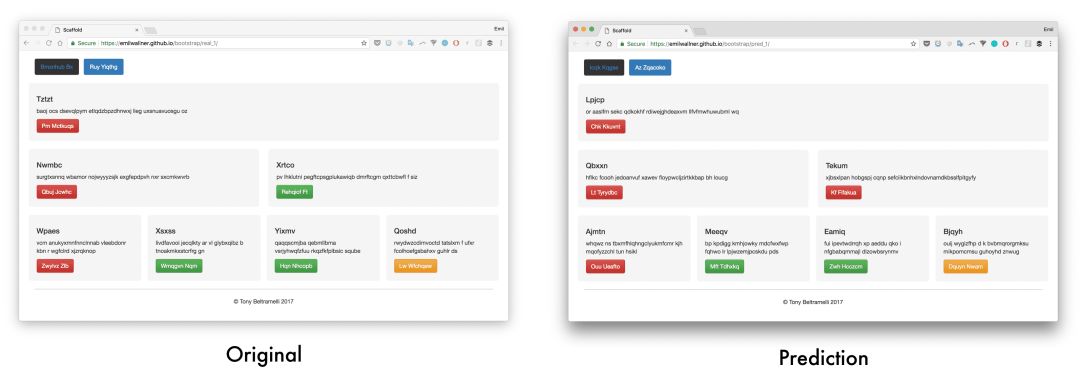
输出示例的链接
网站 1:
-
生成的网站:https://emilwallner.github.io/bootstrap/pred_1/
-
原网站:https://emilwallner.github.io/bootstrap/real_1/
网站 2:
-
生成的网站:https://emilwallner.github.io/bootstrap/pred_2/
-
原网站:https://emilwallner.github.io/bootstrap/real_2/
网站 3:
-
生成的网站:https://emilwallner.github.io/bootstrap/pred_3/
-
原网站:https://emilwallner.github.io/bootstrap/real_3/
网站 4:
-
生成的网站:https://emilwallner.github.io/bootstrap/pred_4/
-
原网站:https://emilwallner.github.io/bootstrap/real_4/
网站 5:
-
生成的网站:https://emilwallner.github.io/bootstrap/pred_5/
-
原网站:https://emilwallner.github.io/bootstrap/real_5/
我犯过的错误
-
学会理解模型的弱点,避免盲目测试模型。刚开始的时候,我随便尝试了一些东西,比如 batch normalization、bidirectional network,还试图实现 attention。看了测试数据后发现这些并不能准确地预测颜色和位置,我开始意识到这是 CNN 的弱点。因此我放弃了 maxpooling,改为增加步长。结果测试损失从 0.12 降到了 0.02,BLEU 分数从 85%提高到了 97%。
-
只使用相关的事先训练好的模型。在数据集很小的时候,我以为事先训练好的图像模型能够提高效率。实验结果表明,端到端的模型虽然更慢,训练也需要更多的内存,但准确率能提高 30%。
-
在远程服务器上运行模型时要为一些差异做好准备。在我的 Mac 上运行时,文件是按照字母顺序读取的。但在远程服务器上却是随机读取的。结果造成了截图和代码不匹配的问题。虽然依然能够收敛,但在我修复了这个问题后,测试数据的准确率提高了 50%。
-
务必要理解库函数。词汇表中的空 token 需要包含空格。一开始我没加空格,结果就漏了一个 token。直到看了几次最终输出结果,注意到它从来不会预测某个 token 的时候,我才发现了这个问题。检查后发现那个 token 不在词汇表里。此外,要保证训练和测试时使用的词汇表的顺序相同。
-
试验时使用轻量级的模型。用 GRU 替换 LSTM 可以让每个 epoch 的时间减少 30%,而且不会对性能有太大影响。
下一步
深度学习很适合应用在前端开发中,因为很容易生成数据,而且如今的深度学习算法可以覆盖绝大多数的逻辑。
其中一个最有意思的方面是在 LSTM 中使用 attention 机制[16]。它不仅能提高准确率,而且可以帮助我们观察 CSS 在生成 HTML 代码的时候,它的注意力在何处。
Attention 还是 HTML 代码、样式表、脚本甚至后台之间沟通的关键因素。attention 层可以追踪参数,帮助神经网络在不同编程语言之间沟通。
但是短期内,最大的难题还在于找到一个可扩展的方法用于生成数据。这样才能逐步加入字体、颜色、单词以及动画。
迄今为止,很多人都在努力实现绘制草图并将其转化为应用程序的模板。不出两年,我们就能实现在纸上绘制应用程序,并在一秒内获得相应的前端代码。Airbnb 设计团队[17]和 Uizard[18] 已经创建了两个原型。
下面是一些值得尝试的实验。
实验
Getting started:
-
运行所有的模型
-
尝试不同的超参数
-
尝试不同的 CNN 架构
-
加入 Bidirectional 的 LSTM 模型
-
使用不同的数据集实现模型[19](你可以通过 FloydHub 的参数“--data ”挂载这个数据集:emilwallner/datasets/100k-html:data)
高级实验
-
创建能利用特定的语法稳定生成任意应用程序/网页的生成器
-
生成应用程序模型的设计图数据。将应用程序或网页的截图自动转换成设计,并使用 GAN 产生变化。
-
通过 attention 层观察每次预测时的图像焦点,类似于这个模型:https://arxiv.org/abs/1502.03044
-
创建模块化方法的框架。比如一个模型负责编码字体,一个负责颜色,另一个负责布局,并利用解码部分将它们结合在一起。你可以从静态图像特征开始尝试。
-
为神经网络提供简单的 HTML 组成单元,训练它利用 CSS 生成动画。如果能加入 attention 模块,观察输入源的聚焦就更完美了。
最后,非常感谢 Tony Beltramelli 和 Jon Gold 提供的研究成果和想法,以及对各种问题的解答。谢谢 Jason Brownlee 贡献他的 stellar Keras 教程(我在核心的 Keras 实现中加入了几个他的教程中介绍的 snippets),谢谢 Beltramelli 提供的数据。还要谢谢 Qingping Hou、Charlie Harrington、 Sai Soundararaj、 Jannes Klaas、 Claudio Cabral、 Alain Demenet 和 Dylan Djian 审阅本篇文章。
相关链接
[1] pix2code 论文:https://arxiv.org/abs/1705.07962
[2] sketch2code:https://airbnb.design/sketching-interfaces/
[3] https://github.com/emilwallner/Screenshot-to-code-in-Keras/blob/master/README.md
[4] https://www.floydhub.com/emilwallner/projects/picturetocode
[5] https://machinelearningmastery.com/blog/page/2/
[6] https://blog.floydhub.com/my-first-weekend-of-deep-learning/
[7] https://blog.floydhub.com/coding-the-history-of-deep-learning/
[8] https://blog.floydhub.com/colorizing-b&w-photos-with-neural-networks/
[9] https://machinelearningmastery.com/deep-learning-caption-generation-models/
[10] https://machinelearningmastery.com/how-to-one-hot-encode-sequence-data-in-python/
[11] https://www.youtube.com/watch?v=byLQ9kgjTdQ&t=21s
[12] https://arxiv.org/abs/1301.3781
[13] https://github.com/tonybeltramelli/pix2code/tree/master/datasets
[14] https://iamtrask.github.io/2015/11/15/anyone-can-code-lstm/
[15] https://en.wikipedia.org/wiki/BLEU
[16] https://arxiv.org/pdf/1502.03044.pdf
[17] https://airbnb.design/sketching-interfaces/
[18] https://www.uizard.io/
[19] http://lstm.seas.harvard.edu/latex/
新的一年已经到来,「CSDN」公众号的目标更加明确,有更多的想法需要落地,不过目前对于小姐姐来说是“现实跟不上灵魂的脚步”,因为缺人~~
所以,「CSDN」公众号要壮大队伍啦,现招聘业界与技术资深编辑记者、资深新媒体运营,有意者请将简历投至:tangxy@csdn.net,期待你的加入!
如果你暂时不能加入我们的队伍一起并肩战斗,也欢迎加入「CSDN」作者大家庭,与所有「CSDN」的朋友们分享你的精彩文章,投稿邮箱:yangli@csdn.net
除了以上两项,如果你热爱技术分享,想要获得更广的视角和更前沿的技术探索,你还可以加入「CSDN」的译者群,利用业余时间,在尊重版权的前提下,翻译对中国开发者极有价值的文章,有意者请将简历投至:guorui@csdn.net

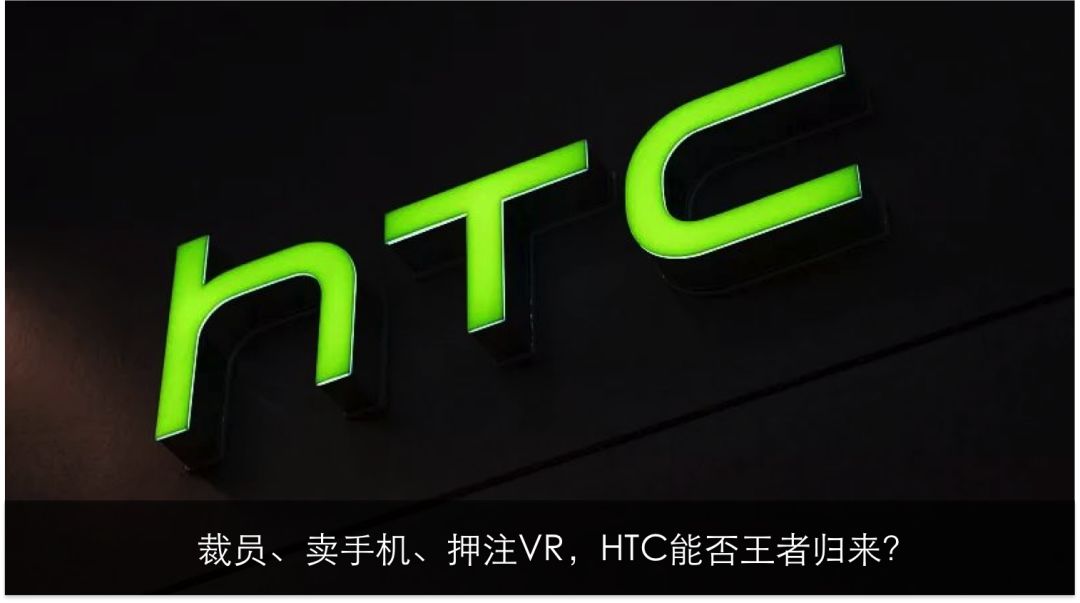
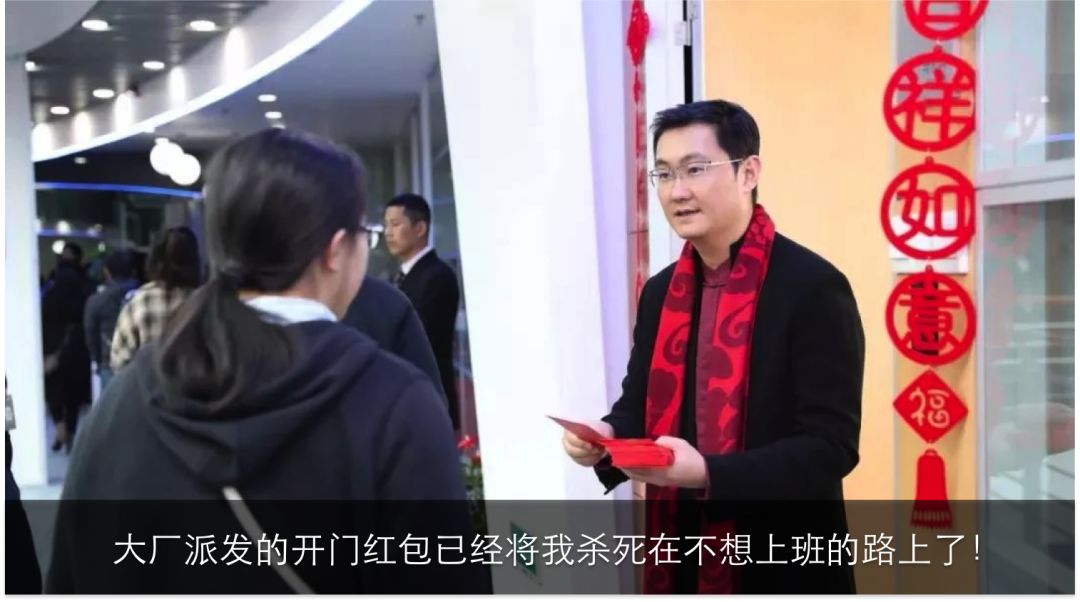


文章评论